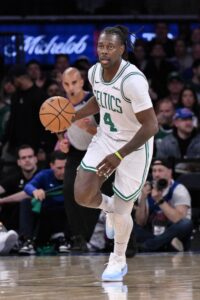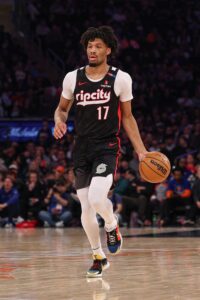Hoops Rumors is checking in on the 2025 offseason for all 30 NBA teams, recapping the summer’s free agent signings, trades, draft picks, departures, and more. We’ll take a look at each team’s offseason moves and consider what might still be coming before the regular season begins. Today, we’re focusing on the Portland Trail Blazers.
Free agent signings
 Damian Lillard: Three years, $41,606,800. Third-year player option. No-trade clause. Signed using non-taxpayer mid-level exception.
Damian Lillard: Three years, $41,606,800. Third-year player option. No-trade clause. Signed using non-taxpayer mid-level exception.- Blake Wesley: One year, minimum salary. Signed using minimum salary exception.
Trades
- Acquired the draft rights to Yang Hansen (No. 16 pick), the Magic’s 2028 first-round pick, the Hawks’ 2027 second-round pick, and the Kings’ 2028 second-round pick from the Grizzlies in exchange for the draft rights to Cedric Coward (No. 11 pick).
- Acquired Jrue Holiday from the Celtics in exchange for Anfernee Simons.
Draft picks
- 1-16: Yang Hansen
- Signed to rookie scale contract (four years, $21,393,587).
Two-way signings
- Caleb Love
- One year, $85,300 partial guarantee (will increase to $318,218 at start of regular season).
Note: The Trail Blazers carried over Sidy Cissoko on a two-way contract from 2024/25.
Departed/unsigned free agents
- Dalano Banton (unsigned)
- Bryce McGowens (Pelicans)
- Justin Minaya (unsigned)
- Jabari Walker (Sixers)
Other roster moves
- Bought out Deandre Ayton (gave up $10,000,000 of $35,550,814 salary).
- Exercised team option on Rayan Rupert ($2,221,677).
Salary cap situation
- Operating over the cap ($154.6MM) and below the luxury tax line ($187.9MM).
- Carrying approximately $186.4MM in salary.
- Hard-capped at $195,945,000.
- Full bi-annual exception ($5,134,000) available.
The offseason so far
Mired in mediocrity (or worse) for several seasons, the Trail Blazers finally experienced a breakthrough in the second half of the 2024/25 season. Following a 13-28 start, they finished the year on a 23-18 run, as a defense that ranked 28th through the first 41 games of the season was the NBA’s third-best across the final 41.
That second-half success was driven largely by Portland’s young players. No Blazer logged more minutes during the final 41 games than Toumani Camara, who was recognized with a spot on the All-Defensive second team. Deni Avdija and Shaedon Sharpe were the team’s leading scorers after the All-Star break, averaging 23.3 and 21.2 points per night, respectively. And 2024 lottery pick Donovan Clingan became the full-time starter at center as Deandre Ayton missed the final 28 games of the season due to a calf injury.
The question entering the summer, then, was would the Blazers continue to patiently add young pieces to their improving core, or would they look to build on their second-half run by adding win-now veterans capable of helping the club get back to the playoffs in 2026?
 The first major agreement Portland’s front office reached this offseason was a trade sending Anfernee Simons and a pair of second-round picks to Boston in exchange for Jrue Holiday. The move raised eyebrows, given that the 26-year-old Simons is on an expiring $27.7MM deal, while the 35-year-old Holiday has three years and $104.4MM left on his contract. It seemed to be a signal that the Blazers, leaning into the defense-first identity they established during the final months of the 2024/25 season, were focused on taking another step forward in the short term.
The first major agreement Portland’s front office reached this offseason was a trade sending Anfernee Simons and a pair of second-round picks to Boston in exchange for Jrue Holiday. The move raised eyebrows, given that the 26-year-old Simons is on an expiring $27.7MM deal, while the 35-year-old Holiday has three years and $104.4MM left on his contract. It seemed to be a signal that the Blazers, leaning into the defense-first identity they established during the final months of the 2024/25 season, were focused on taking another step forward in the short term.
But the rest of the Blazers’ offseason moves didn’t really fit that narrative. On draft night, the front office moved down from No. 11 to 16 and made arguably the most shocking pick of the first round by nabbing Chinese center Yang Hansen. The big man wasn’t widely projected to come off the board in round one — ESPN had ranked him 35th overall, while The Athletic had him at No. 48 on its big board. But there were rumblings that the Blazers didn’t feel comfortable moving down any further than No. 16 because they believed another team was eyeing Hansen within the next few spots.
The long-term potential of Hansen, who has earned comparisons to Yao Ming and Nikola Jokic, is tantalizing, and he showed flashes of brilliance in the Las Vegas Summer League. But the 20-year-old will require some patience and probably isn’t ready to play a major role right away for a team with postseason aspirations.
The Blazers continued to show with their next couple moves that they aren’t necessarily all-in on contending in the immediate future — they bought out Ayton, their maximum-salary starting center, a day before free agency opened, then reached a deal a few weeks later to reunite with Damian Lillard, who will spend the 2025/26 season recovering from an Achilles tear.
Ayton’s buyout wasn’t a total shocker, given the emergence of Clingan and the addition of Hansen, but it signals that Portland is comfortable turning the frontcourt over to its youngsters. As for the reunion with Lillard, who spent his first 11 seasons with the Blazers, the 35-year-old is theoretically a win-now piece, but he won’t be able to contribute at all for a year. If the team were more focused on making the postseason in ’25/26, it could have used its mid-level exception on a rotation player who will actually be healthy and available.
With the benefit of hindsight and a more complete picture of the Blazers’ offseason moves, the Holiday trade – which ended up being completed without the two second-round picks due to minor concerns about the guard’s physical – reads a little differently. The two-time NBA champion is being brought in to supplement, rather than supplant, the young duo of Sharpe and Scoot Henderson, who should benefit from Holiday’s veteran leadership and his ability to take on the tougher defensive assignments in which Simons would’ve been overmatched.
It’s fair to question whether it was the right move for the Blazers to invest in a mid-30s guard who is making nearly $35MM per year and whose production slipped to new lows in 2024/25. But it certainly still seems like the ultimate goal in Portland is to build around that young core. After Avdija, Camara, and Clingan showed last season that they’re very much on the right track, the Blazers are hoping that Holiday’s guidance will help ensure that Sharpe and Henderson are right there with them.
The other major story of the Blazers’ offseason broke within the last week, as billionaire Tom Dundon reached a tentative agreement to purchase the franchise from Paul Allen‘s estate.
It’s hard to get a clear sense of how a new team owner will operate until he actually takes control and starts making moves, and it may be a little while before that happens, since the deal will require the approval of the NBA’s Board of Governors. But Blazers fans should be encouraged by the job Dundon has done with the NHL’s Carolina Hurricanes since buying the team in 2018. On the heels of a nine-year playoff drought, the Hurricanes have made the postseason seven straight times and won nine playoff series in Dundon’s first seven full seasons as majority owner.
Up next
The Trail Blazers have 15 players on fully guaranteed contracts and only have a little breathing room below the luxury tax line, so unless they plan to make a trade before the preseason begins, their roster looks pretty set.
Having said that, it’s worth noting that there’s no shortage of trade candidates on the roster — Jerami Grant and Robert Williams, for instance, likely aren’t part of the long-term plans in Portland, and Williams is on an expiring contract. But Grant has a sizable cap hit and is coming off a down year, while Williams has only appeared in 26 games over the past two seasons due to injuries, so neither one has much trade value at this point.
Portland does have a two-way contract slot open, with no obvious candidate to fill it. If they don’t sign anyone to a two-way deal in the coming weeks, there could be an open competition in training camp for that spot. Undrafted rookies Sean Pedulla and Andrew Carr are among the players said to have received camp invites on Exhibit 10 contracts.
 With no major roster decisions on tap in the short term, the Blazers’ biggest decision this fall may be whether or not to extend Sharpe. The former seventh overall pick has been inconsistent as a shooter and defender since entering the NBA and missed most of his second year due to an abdominal injury, but he’s an incredible athlete who is still just 22 years old and has exhibited legitimate scoring ability — he put up a career-best 18.5 points per game last season.
With no major roster decisions on tap in the short term, the Blazers’ biggest decision this fall may be whether or not to extend Sharpe. The former seventh overall pick has been inconsistent as a shooter and defender since entering the NBA and missed most of his second year due to an abdominal injury, but he’s an incredible athlete who is still just 22 years old and has exhibited legitimate scoring ability — he put up a career-best 18.5 points per game last season.
Finding the right price for Sharpe could be tricky, but if the Blazers are still big believers in his upside and think a breakout could be around the corner, this might be their best chance to sign him to a team-friendly long-term contract. Of course, if Sharpe and his camp believe the same thing, they probably won’t be inclined to settle for too modest a deal. Perhaps there’s a middle ground for Sharpe and the Blazers somewhere between the four-year rookie scale extensions signed a year ago by Corey Kispert ($54MM) and Trey Murphy ($112MM).
While Sharpe has an Oct. 20 deadline for a rookie scale extension, there’s no such restriction for Camara, who will remain eligible for a veteran extension all season long, assuming his minimum-salary team option for 2026/27 is declined as part of an agreement. Camara would be eligible to receive up to approximately $87MM for four seasons on an extension starting in ’26/27 or roughly $63MM over three seasons if his ’26/27 option is exercised and a new deal begins in ’27/28.
The former second-round pick earned praise from opponents for his defensive tenacity and showed off an improved offensive game in his second NBA season, knocking down 37.5% of his three-point attempts. He’s an important part of the future in Portland.
Starting an extension for Camara a year later would benefit the Blazers, who are in position to have some cap flexibility during the 2026 offseason. But if giving him a significant raise in ’26/27 is what it takes to get a deal done, Portland shouldn’t hesitate to pull the trigger — especially since, without an extension, the team may end up needing to decline that option anyway in order to make him a restricted free agent next July.
Thanks for the fantastic and thorough article, Luke!
Portland’s future may finally be looking bright, long-term. That hasn’t happened since the Blazers had the (potential) “dynasty” of Aldridge, Roy, and Oden. We know how that worked out.
Hopefully they’re just another move or two away, along with continued growth from the young guys, from being seriously relevant again in the west in 26-27, and beyond.
Yang Hansen will be the 2nd best player out of the draft. He has all star potential. All he needs to do is become a better shooter. His passing is better than Cooper’s passing.
My understanding is that his defense is the major question mark.
The west is tougher than last year. Can they make the play-in?
I say no. Doesn’t mean the team isn’t better than last year tho
Offer Clingan and Murray to Utah for Walker Kessler and Taylor Hendricks.
Offer Grant, Holiday and pick to Washington for Middleton and McCollum
Waive Blake Wesley
Sign a veteran C (30+)
Sign Jaylen Martin on a two contract
I, like many, like the seedlings growing underground here in Por
I just don’t love the top soil here and I don’t think giving Dame 3 years helped that aspect which should be the main (only) prerogative today
It probably wont matter too much in the end as I think they are going to need a 2 year runway either way but Imo the best move would be for new ownership to find a COMPLETELY different front office moving forwards ASAP.
Cronin is clueless, bottom barrel, clean shop if Im Tom Dundon, take it slow and probably more ready to pounce when Grant becomes an expiring . They have to untie a few knots left by Joe before pushing chips
Blazers still very young. Their future is all about Scoot and Sharpe. And this is still a work in progress. I am not a fan of starting 19-20 yr olds. Especially without good vets around them. Holiday should help Sharpe and Scoot the most. He is an excellent guy to learn from. Blazers had a good second half. So I guess they have to build on that. I still want to know. Why they gave up on Ayton.
@LukeAdams
Love these offseason check-in’s. Keep them coming.
Great work!